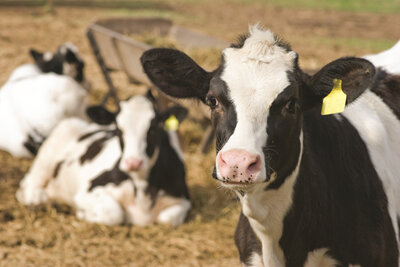
Good rearing of calves is the key to a successful dairying operation. The lifetime production of a cow is determined by how well it is reared as a calf.
The key to rearing good calves is to get the basics right at the very beginning. Calves that are poorly grown up to weaning never recover and will result in poorly grown heifers.
Colostrum
Colostrum contains immunogloblins at levels 60 times that of whole milk and is 20% higher in energy than whole milk. The immunoglobulins provide protection against infections such as navel ill and neonatal scours.
Calves (including bobby calves) require 2 to 4 litres of colostrum within the first 10 hours after birth. 50% of calves will naturally get this amount of colostrum in the required time. Calves suckling well will get this amount in the first 6 hours but slow suckers will still be slow suckers 24 hours after birth. The best way to ensure that calves get good quantities of colostrum is to remove them from the cow within 6 hours of birth and feed colostrum or tube them with 2 litres of colostrum.
Milk and Milk Powder
The following choices are available for rearing calves in energy order:
Stored Colostrum
This is the very best of calf foods, being higher in energy and protein, and immunoglobulins than the other alternatives. Selling colostrum for manufacturing is like selling the family jewels. It is important that antibiotic-containing milk is not added to stored colostrum because this affects the keeping quality of the colostrum.
Whole Milk
Next best for energy, and the natural calf-rearing food.
Commercial Milk Replacers (CMR’s)
These are a mixture of dairy based products including skim milk powder, whey, casein and buttermilk. They typically contain 18% fat as opposed to whole milk powder at 28%, and 10% less energy than whole milk.
Soya CMR’s
The ingredients vary, but most contain whey (protein and lactose), soya (protein), and vegetable oil (fat). The soya needs trypsin inhibitors added and the starch removed (which is not digestible by the calves).
The digestibility of these products varies. Poorly digestible products allow more lactose and protein to pass through the abomasum quicker allowing the potential for more bacterial multiplication. Colostrum and whole milk form a good curd which is easily digestible. CMR’s vary and can be checked by submitting a sample to your nearest VetEnt clinic for testing.
Soya products do not form a clot. Some have been used successfully overseas but work best in controlled environments. They should be fed at 40°C to increase gut motility, increase gastric juices, and protein digestibility. Some experienced calf rearing consultants believe these products should only be used to finish off the rearing process in New Zealand conditions.
Meal and Roughage
Good quality meal should always be available. Most meals contain 18 – 20% protein, and should contain a coccidiostat. A successful regime is to have calves eating at least 0.5kg of meal at 8 weeks of age, then to increase to 1 – 1.2kg at weaning until the calf is at least 12 weeks of age or 100Kg. Similarly good quality roughage should be available from birth. Best is meadow hay. This is to assist the development of the rumen so the rumen is fully functioning at the time of weaning.
Water
Calves from birth should have access to good quality water.
Housing
Good quality housing is essential and there are a few fundamental requirements:
When calves are brought into the calf shed for the first time their navels must be treated with a good quality iodine based spray. The navel should be checked regularly to make sure that it is drying up and there is no sign of infection.
Post-weaning
Weaning is a very stressful time for calves and the transition should be smooth with the continuation of meal feeding for the first month after weaning.
Scouring calves
Nitrate Poisoning
This can happen at any time but usually at the time when grass is very rapidly growing – over the summer in the good times and the autumn, and often with new grass. Symptoms include cattle found dead, staggery, or down. The mucus membranes (inside the mouth and under the eyelids) appear brown or muddy. If treatment is started quickly, cattle can be saved; there is a very good antidote. As a preventative, grass samples can be taken to check the nitrate levels.
Performance Monitoring and Target Weights
If farmers are able to weigh their own animals this is a very good management tool. Target weights can be set according to the breed, and the animals monitored.